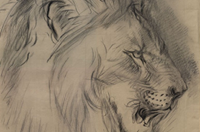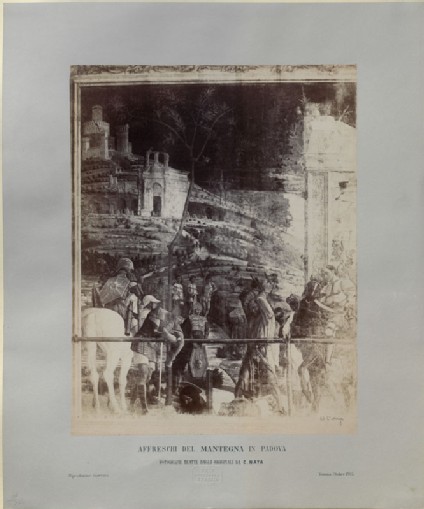Ruskin's Standard & Reference series (1872)
Exemplary works of art. In the catalogue of the Reference series, items marked 'M' are drawings "by my own Hand" (by Ruskin), P are photographs, E engravings and A by Ruskin's Assistant, Arthur Burgess.

Ruskin's Catalogues: 1 object
Show search help- Reference URL
Actions
Photograph of Mantegna's Fresco of "The Martyrdom of Saint James" in the Church of Eremitani, Padua Carlo Naya, firm
-
Ruskin text
35. Martyrdom of St. James. (Mantegna.) Photograph from fresco in church of Eremitani at Padua .You will probably at first see little to admire in this; but, as you learn to draw, and as your taste is formed in ornamental design, you will return to it with continually increasing astonishment. I hope to illustrate various portions of it separately.
-
Curator’s description:
Description
Part of the painted frame which encloses this field of the fresco can be seen on all edges save the right. Most of the figures are arranged along the bottom of the picture, behind a fence. Saint James lies flat on the ground on his front, his head on the left and his neck placed between two short stakes, between which hangs a broad horizontal blade. His executioner stands above him, to the right, his arms raised above his head to hold the huge mallet which hangs behind his back, ready to strike the blade above the saint's neck. To either side of them are several onlookers. A ruined fragment of classical architecture runs up the right edge; a small owl sits amongst the plants growing at its top. In the background, the ground rises steeply to a series of large semi-classical buildings in a state of disrepair, enclosed by a long wall further down the slope, presumably representing Jerusalem, the site of Saint James's execution.
Ruskin identified this as one of the frescoes painted in the Church of Eremitani at Padua. These were part of a scheme painted in the Ovetari Chapel of the church from 1448 to 1457 by a group of artists comprising Andrea Mantegna, Giorgio d'Alemagna, Ansuino da Forlì and Bono da Ferrara, for the executors of Antonio di Biagio degli Ovetari. The majority of the frescoes were severely damaged by Allied bombing in 1944.
The photograph first appears in the Teaching Collection in 1870, when Ruskin listed it as no. 35 in the Standard Series in the "Catalogue of Examples". It retained this position in the 1872 catalogue of the series.
In his catalogue, Ruskin described how his students' appreciation of the picture would gradually grow as they learned to draw and developed their taste in ornamental design. This seems to have matched his own attitude to the frescoes, as he noted in a letter to Charles Eliot Norton of 8 July 1870 that 'We had a lovely day at Padua, and I see Mantegna with ever-increasing admiration' (XXVII.10). In fact, he used copies of details from the picture for several of the examples in the Teaching Collection: no. 220 in the Educational Series and no. 298 in the Rudimentary both reproduce a spray of oak leaves from the tree in the foreground, whilst no. 46 in the Rudimentary Series depicts the owl sitting on the foreground architecture.
-
Details
- Artist/maker
-
Carlo Naya, firm (active 1850s - 1918) (photographer)after Andrea Mantegna (1430/31 - 1506)
- Object type
- photograph
- Material and technique
- albumen print
- Dimensions
- 347 x 270 mm (print); 476 x 397 mm (original mount)
- Associated place
-
- Asia › Israel › Jerusalem District › Jerusalem › Jerusalem (subject)
- Inscription
- On the photograph, apparently scratched onto the negative to print black: 63. Co. Naÿa
On the mount:
bottom centre, printed: AFFRESCHI DEL MANTEGNA IN PADOVA | FOTOGRAFIE TRATTE DAGLI ORIGINALI DA C. NAYA
bottom left, printed: Riproduzione riservata.
bottom right, printed: Venezia, Ottobre 1865
bottom centre, blind-stamped within a rectangular border, its corners trimmed diagonally: NAYA | FOTOGRAFO | VENEZIA
bottom left, in graphite: r/e | 7/- [the two lines separated by a horizontal bar]
- Provenance
-
Presented by John Ruskin to the Ruskin Drawing School (University of Oxford), 1875; transferred from the Ruskin Drawing School to the Ashmolean Museum, c.1949.
- No. of items
- 1
- Accession no.
- WA.RS.STD.035
-
Subject terms allocated by curators:
Subjects
-
References in which this object is cited include:
References
Ruskin, John, Catalogue of Examples Arranged for Elementary Study in the University Galleries (Oxford: Clarendon Press, 1870), cat. Standard no. 35
Ruskin, John, Catalogue of the Reference Series Including Temporarily the First Section of the Standard Series (London: Smith, Elder, [1872]), cat. Standard no. 35
Ruskin, John, ‘The Ruskin Art Collection at Oxford: Catalogues, Notes and Instructions’, Edward T. Cook and Alexander Wedderburn, eds, The Works of John Ruskin: Library Edition, 39 (London: George Allen, 1903-1912), 21, cat. Standard no. 35
Location
-
- Western Art Print Room
Position in Ruskin’s Collection
Ruskin's Catalogues
-
Ruskin's Catalogue of Examples (1870)
35. Martyrdom of St. James. (Mantegna .) Photograph from fresco in church of Eremitani at Padua.You will probably at first see little to admire in this; but, as you learn to draw, and as your taste is formed in ornamental design, you will return to it with continually increasing astonishment. I hope to illustrate various portions of it separately.
-
Ruskin's Standard & Reference series (1872)
35. Martyrdom of St. James. (Mantegna.) Photograph from fresco in church of Eremitani at Padua .You will probably at first see little to admire in this; but, as you learn to draw, and as your taste is formed in ornamental design, you will return to it with continually increasing astonishment. I hope to illustrate various portions of it separately.






